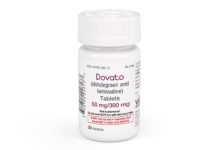The efficacy of antiretroviral therapy is significantly compromised by medication non-adherence. Long-acting enteral systems that can ease the burden of daily adherence have not yet been developed. Here we describe an oral dosage form composed of distinct drug–polymer matrices which achieved week-long systemic drug levels of the antiretrovirals dolutegravir, rilpivirine and cabotegravir in a pig.
Simulations of viral dynamics and patient adherence patterns indicate that such systems would significantly reduce therapeutic failures and epidemiological modelling suggests that using such an intervention prophylactically could avert hundreds of thousands of new HIV cases. In sum, weekly administration of long-acting antiretrovirals via a novel oral dosage form is a promising intervention to help control the HIV epidemic worldwide.
Antiretrovirals have transformed disease management for human immunodeficiency virus (HIV)-infected individuals. With reliable life-long adherence to combination antiretroviral therapy (ART), HIV+ individuals have a lifespan comparable to that of uninfected individuals. Additionally, antiretrovirals may be taken by high-risk uninfected individuals to prevent infection, a strategy known as pre-exposure prophylaxis (PrEP). When used consistently, PrEP reduces HIV acquisition rate by 90%. Despite these developments, the burden of HIV remains high worldwide. In 2015, 2.1 million people became newly infected with HIV, and there were 1.2 million HIV-related deaths. These findings underscore the need to bridge the disconnect between availability of effective antiretrovirals and efficient disease control.
Lack of medication adherence to ART has emerged as a key barrier to successful HIV treatment and prevention. The average adherence rate to long-term ART is ~70%, in both high- and low-income countries, and suboptimal adherence is the strongest predictor of treatment failure and emergence of drug-resistant virus. Further, poor adherence has also emerged as a barrier to successful implementation of PrEP. For example, lack of efficacy of various formulations of tenofovir-based PrEP in the VOICE trial were explained, in part, by undetectable drug levels in many participants and imperfect adherence was also implicated for the lack of efficacy in the FEM-PrEP trial. Additionally, analyses of the CAPRISA and iPrEx trials revealed that patients with better adherence to the therapeutic regimen were more likely to be protected.
Adherence levels are driven by a variety of factors, including access to affordable medications, stigma about disease status, and side effects of ART. The high pill burden resulting from daily long-term HIV medication is known to significantly deter patient adherence. To overcome this challenge, there has been interest in developing simplified dosage regimens. One example is single-tablet regimens, such as Atripla®, Complera®, and Stribild®, although these still require daily pill administration. Another recent breakthrough is the use of long-acting injectable nanoparticles, which release drug for weeks after intramuscular administration. However, their long-term favourability among patients and their effect on adherence requires careful assessment, as pain and other injection site reactions have been commonly reported and adherence to other injectables, such as hormonal contraception, is low.
We reasoned that a technology that reduces dosing frequency and is administered orally could be a promising alternative for addressing imperfect adherence to ART. However, development of such a system has previously proven difficult due to the limited residence of drugs in the gastrointestinal tract. Moreover, although structures with prolonged gastric residence have been reported, restrictions on materials that can be used for their construction limit the ability to adequately control drug release kinetics. For example, we have previously reported gastric resident dosage forms fabricated from poly(ε-caprolactone) (PCL) capable of providing both the mechanical integrity required for gastric residence and slow drug release for long-term treatment with ivermectin. The coupling of mechanical resilience enabling gastric residence with drug release limited initial formulation to PCL. To develop an orally delivered dosage form with the capacity to provide extended release of a wide range of therapeutics in nearly any time release profile, a universal system capable of accommodating a wide range of polymer formulations would be required.
Here we describe such a universal system and apply it to the clinical problem of medication non-adherence in HIV. To address the challenges of prolonging gastric residence and altering drug formulations independent of mechanical properties, we describe here a modular drug delivery system which folds and recoils, enabling oral dosing, which retains its integrity in the stomach for prolonged residence, and which can be loaded with up to six different drug formulations resulting in desired pharmacokinetics. As a proof-of-principle, we show that this system is capable of delivering three highly-potent antiretrovirals—dolutegravir (DTG), cabotegravir (CAB) and rilpivirine (RPV)—for a week after a single dose in a swine model.


 ПОИСК ПО САЙТУ
ПОИСК ПО САЙТУ  поиск по ресурсному центру
поиск по ресурсному центру 



